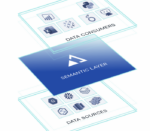In the words of Hank Williams Jr.: “Are you ready for some football?”
The New York Jets football organization certainly is with its new Command Center touch-screen application. Jets owner Woody Johnson used the business intelligence application for the first time during the Jets’ first regular season football game against the Baltimore Ravens at the New Meadowlands Stadium.
While using the application’s dashboard, called “The Pocket,” Johnson and other permitted individuals can access live, real-time data on tickets, merchandise, concessions and parking.
Made up of two pieces, the Jets developed a .NET application to pull data from data files to be placed into a common source, explained David Simbandumwe, engagement director at Roundarch, a designer of digital experiences that helped with the application’s development.
This particular portion of the application includes an ETL (extract, transform and load) process that accesses data feeds from point-of-sale systems Micros, Retail Pro and TicketMaster, and it summarizes the data into a consistent format, according Roundarch’s technical specs.
Roundarch built a J2EE server-side application, which retrieves the information from the database, and a touch-screen or client-side application to render everything, Simbandumwe added. The touch-screen utilizes Adobe AIR and Gesture Works, a solution for creating multi-touch applications, for touch-screen interactions, and it runs on the Windows 7 operating system.
Aside from ticket and merchandise data, additional details can be seen by moving portions of a model of the stadium and zeroing in on certain areas via the touch-screen. For example, Simbandumwe said, the application can compare the weather from two games ago, which was cold and rainy, to today’s sunny and clear weather, which in turn can show the impact of sales on hats and jackets by focusing on merchandise stores in the stadium, he said.
Roundarch came to work with the Jets when a former Jets and current Roundarch architect Jesse Freeman put the two organizations in touch. After the ball got rolling, Simbandumwe said, the challenge came in finding the tools that worked best together.
“Touch-screen applications are relatively more married to hardware, so it was a challenge finding the set of tools that work effectively together,” he said. “And finding out how to assemble the application was fairly challenging as well.”
From the Jets’ perspective, the decision to use Microsoft technologies was based on available skill sets within its technology organization. Roundarch decided to work with a Flex/J2EE stack because of its maturity and its ability to run as a standalone application outside the browser.
Also, working with closed and proprietary systems always has its challenges, Simbandumwe added. “Traditional point-of-sale applications such as TicketMaster are used to generate a report at the end of an event. But now we’re saying we’re going to query you at certain intervals, and you need to give us good and up-to-date data,” he said.
To overcome this, the Jets designed a TicketMaster data feed that utilizes TicketMaster’s Archtics database. “We are able to query the hosted server for barcode data within a minute of being scanned,” said Paul Marsh, senior manager of website technology with the Jets organization, in an e-mail.
From there, information such as when someone entered a parking lot to when they entered the stadium is tied together, he added.
There was also the decision on customization and what the interface should look like, Simbandumwe said. In this particular case, the data is sliced and diced according to time and locations within the stadium. That data is then represented on a mockup of the stadium, along with a “game clock.” It gets its data from an NFL feed called Game Statistics and Information System.
The stats from a particular game, such as temperature and score, are recorded and stored in the database, Simbandumwe said. Using the “game slider” control in the application, the data is called up “to reflect the values at that point in time during the game,” such as how much merchandise was sold by the end of the second quarter, he added.
Command Center Technical Specs:
Data Load:
– Hardware: Dell PowerEdge R710 Rack Server
– OS: Windows Server 2008
– Application architecture: C#
Server-Side:
– Hardware: Dell PowerEdge R710 Rack Server
– OS: Windows Server 2008
– Database: SQL Server 2008
– Application server: JBoss Enterprise Application Platform 5
– Application architecture: J2EE service-based architecture
– Frameworks: BlazeDS 3.2, Hibernate 3, Spring 3
Client Application:
– Hardware: HP 42-inch LD4200tm and Sony VAIO L Series VPCL135FX/B
– OS: Windows 7
– Runtime: AIR Version 2
– Frameworks: Flex 4, Gesture Works 1.5, Robotlegs





